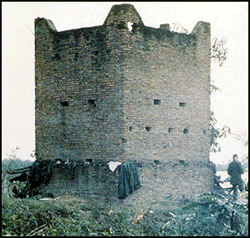The exact date is still unknown as to when the first MP’s were assigned to duty at the outpost following Operation CORRAL and the start of Operation STABILIZE. What is known is that in August 1967 a combined platoon of battalion MP's from A, B and C Companies was formed to conduct ambush and recon patrols in the TAOR. The platoon was headed by 2LT Robert S. Wilkerson, of B Company and included, SGT Ward Gunard Walter (KIA 29 Nov 68), and SP/4 Robert R. "Andy" Anderson, of B Company, SP/4 Appamenio Lara (KIA 30 May 68) of C Company, and others yet to be identified. In addition to TAOR reconnaissance patrols the platoon also performed outpost inspections as a prelude to Operation STABILIZE.
September 1967 The overall daily command and control of the TAOR was conducted through the 720th Battalion Tactical Operations Center (TOC). During the first phases of TAOR operations all three letter companies in addition to the 615th MP Company were assigned joint and unit specific missions and areas of operation (AO).
March 1968 There were four outpost located within the TAOR jointly staffed by Battalion MP’s of all three letter companies and local PF’s. They were Outpost #1 in An Xuan, and Outpost #2 in Long Hung that were manned by B Company MP’s who physically lived at the OP. Outpost #3 at the entrance to An Hoa Hung was manned by C Company and Outpost #4 at Long Binh Tan was manned by A Company MP’s, who worked it in 12 hour shifts.
The B Company Outpost’s #1 and #2 were staffed with a minimum of four MP’s each, usually commanded by an NCO the rank of Sergeant (E-5), when available. The C and A Company outpost’s, #3 and #4 respectively, were staffed by an average of two to three MP’s during each shift. In addition to the Operation STABILIZE TAOR staffing mission, all three letter companies also continued their convoy escort and discipline, law, and order missions.
March April and May 1968 There were several Battalion sized village cordon and search operations similar to Operation CORRAL and conducted for the same purposes. During the first two cordon and search operations in April and May of 1968 the 116 man 301st National Police Field Forces Company was assigned to the operational control of the Battalion. Members were integrated into the Battalion Tactical Operations Command [TOC] to insure coordination of all NPFF operations. Their American advisor and the bulk of the company stayed at Outpost #2 where their headquarters in the TAOR was based during the joint operations.
26 June 1968 This level of staffing and assignment at the outposts changed when the Operation STABILIZE missions were consolidated by the Battalion and assigned exclusively to B Company. A and C Companies withdrew their TAOR staff and reassigned them to their other missions. All four outpost were now being staffed by B Company MP’s who physically resided in them, 24 hours a day, seven days a week.
The staffing levels at each outpost would vary depending on availability of men, enemy activity in their respective areas, and other company priorities. With B Company now being responsible for all TAOR operations, mission coordination improved greatly, however staffing shortages would be a recurring theme throughout the history of Operation STABILIZE. Outpost duty would remain the red headed stepchild of the battalion and company logistical priorities and staffing.
In addition to the consolidation of the Operation STABILIZE missions under one company, the daily tactical operational control of the TAOR would also be handled through the new B Company TOC building. This included not only the responsibility of the outposts, but also the river patrols, ambush and recon teams, and assisting with the 89th MP Group, and 720th MP Battalion civic action programs (CAP) planned for the villages.
1969 The four principal village outpost began to have their staff of MP’s removed and reassigned to other company priorities. This realignment of outpost priorities is believed to have occurred for two reasons.
The first being the primary goal of Operation STABILIZE was being accomplished, in which the counter insurgency and pacification mission in the populated western half of the TAOR was successful and would now become the primary responsibility of the Vietnamese National Police and local Popular Forces supported by B Company daytime Civic Action Patrols and evening ambush and recon patrols.
The second being the focus of the Long Binh Post security was now the two new B Company base camps (outpost) that were built in the eastern unpopulated sector of the TAOR during April through June of 1969 .
With the successful results of the B Company defense of Long Binh Post during the 23 February 1969 attack, the eastern half of the TAOR was immediately identified as the defensive weak spot. With two new static base camps (outpost) in the eastern sector to staff around the clock, and troop reductions under the Vietnamization program underway, the B Company manpower was stretched thin.
2 August 1969 the MP’s from B Company were entirely removed from the four village outpost and their mission became the responsibility of the local Popular Forces and National Police.
12 July 1970 Operation STABILIZE came to a close and all the remaining TAOR tactical responsibilities were transferred to the local ARVN, Regional Forces - Popular Forces and National Police, with US support coming from the 25th Infantry Division.
The unique and historical infantry mission of Operation STABILIZE under the 720th MP Battalion and B Company came to a successful close. |






